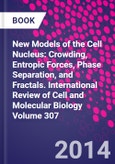International Review of Cell and Molecular Biology presents current advances and comprehensive reviews in cell biology--both plant and animal. Articles address structure and control of gene expression, nucleocytoplasmic interactions, control of cell development and differentiation, and cell transformation and growth. Impact factor for 2012: 4.973.
Ideas from the fields of biophysics, physical chemistry, of polymer and colloid, and soft matter science have helped clarify the structure and functions of the cell nucleus. The development of powerful methods for modeling conformations and interactions of macromolecules has also contributed. The book aims to encourage cell and molecular biologists to become more familiar with and understand these new concepts and methods, and the crucial contributions they are making to our perception of the nucleus.
Please Note: This is an On Demand product, delivery may take up to 11 working days after payment has been received.
Table of Contents
- The Nuclear Physique
Thoru Pederson - The Crowded Nucleus
Ronald Hancock - Crowding in Polymer-Nanoparticle Mixtures
Alan R. Denton - Crowding-Induced Formation and Structural Alteration of Nuclear Compartments: Insights from Computer Simulations
Eun Jin Cho, Igal Szleifer and Jun Soo Kim - Phase Separation as a Possible Means of Nuclear Compartmentalization
William M. Aumiller, Jr, Bradley W. Davis and Christine D. Keating - Formation of Multi-Protein Assemblies in the Nucleus: The Spindle Assembly Checkpoint (SAC)
Victor M. Bolanos-Garcia - Characteristic Behavior of Crowding Macromolecules Confined in Cell-Sized Droplets
Miho Yanagisawa, Takahiro Sakaue and Kenichi Yoshikawa - Non-Canonical Structures and their Thermodynamics of DNA and RNA Under Molecular Crowding: Beyond the Watson-Crick Double Helix
Naoki Sugimoto - Computational Models of Large-Scale Genome Architecture
Angelo Rosa and Christophe Zimmer - How Chromatin Looping and Nuclear Envelope Attachment Affect Genome Organization in Eukaryotic Cell Nuclei
Hansjoerg Jerabek and Dieter W. Heermann - Crowding, Diffusion, and Biochemical Reactions
Matthias Weiss - Importance of Crowding in Signaling, Genetic, and Metabolic Networks
Pieter Rein ten Wolde and Andrew Mugler - Relevance and Limitations of Crowding, Fractal, and Polymer Models to Describe Nuclear Architecture
Sébastien Huet, Christophe Lavelle, Hubert Ranchon, Pascal Carrivain, Jean-Marc Victor and Aurélien Bancaud
Authors
Ronald Hancock Laval University Cancer Research Centre, Québec, Canada.Ronald Hancock obtained a PhD in Microbiology at Cambridge, UK and was a postdoc at Harvard Medical School. He worked at the Swiss Cancer Institute and is now a professor in the Department of Molecular Biology and the Cancer Research Centre of Laval University in Québec, Canada.
His research focuses on the structure of the cell nucleus and chromosomes, and he also teaches and collaborates on studies of DNA repair with scientists in the Biosystems Group of the Silesian University, Gliwice, Poland. He is Editor of two volumes on "The Nucleus" in the series "Methods in Molecular Biology" (Springer) and of a Chapter entitled "The crowded environment of the genome" in the book "Genome organization and function in the cell nucleus" (Wiley). He represents Canada on the International Committee of the International (William Bernhard) Workshop on the Cell Nucleus.
Kwang W. Jeon University of Tennessee, Knoxville, TN, USA.
Kwang Jeon received his Ph.D. in cell physiology at King's College, University of London, UK, in 1964 and taught at SUNY Buffalo and University of Tennessee. His research was concerned with the biogenesis and function of cell components in two major areas: Integration of intracellular symbionts into host cells leading to the acquisition of new cell components and cell variation; Membrane-protein recycling during endo- and exocytosis.








